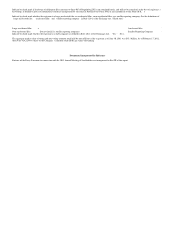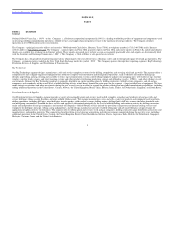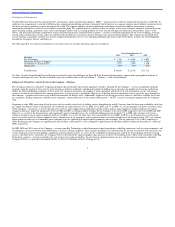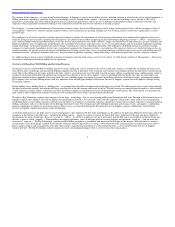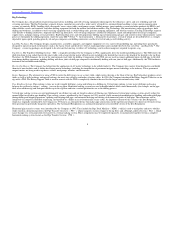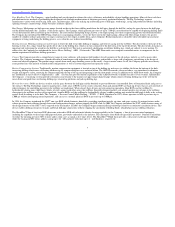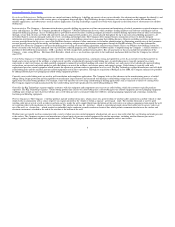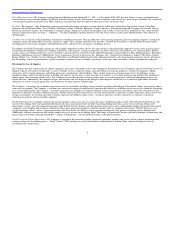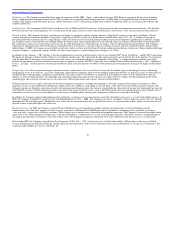National Oilwell Varco 2012 Annual Report Download - page 5
Download and view the complete annual report
Please find page 5 of the 2012 National Oilwell Varco annual report below. You can navigate through the pages in the report by either clicking on the pages listed below, or by using the keyword search tool below to find specific information within the annual report.
Index to Financial Statements
The majority of the Companys revenue from Petroleum Services & Supplies is closely tied to drilling activity, although a portion is related to the sale of capital equipment to
drilling contractors, which may somewhat lag the level of drilling activity. Portions of the segments revenue that are not tied to drilling activity include (i) the sale of
progressive cavity pumps and solids control equipment for use in industrial applications, and (ii) the sale of fiberglass and composite tubing to industrial customers and
shipyards, which is generally unrelated to drilling or well remediation activity but may be tied somewhat to oil and gas prices.
The Companys revenue from Distribution & Transmission is almost entirely driven by drilling activity and oil and gas production activities, with the exception of sales of
water pipelines, wind towers, concrete and pole products which is tied to infrastructure spending. Drilling and well servicing activity can fluctuate significantly in a short
period of time.
The willingness of oil and gas operators to make capital investments to explore for and produce oil and natural gas will continue to be influenced by numerous factors over
which the Company has no control, including but not limited to: the ability of the members of the Organization of Petroleum Exporting Countries (OPEC) to maintain oil
price stability through voluntary production limits of oil; the level of oil production by non-OPEC countries; supply and demand for oil and natural gas; general economic and
political conditions; costs of exploration and production; the availability of new leases and concessions; access to external financing; and governmental regulations regarding,
among other things, environmental protection, climate change, taxation, price controls and product allocations. The willingness of drilling contractors and well servicing
companies to make capital expenditures for the type of specialized equipment the Company provides is also influenced by numerous factors over which the Company has no
control, including: the general level of oil and gas well drilling and servicing; rig day-rates; access to external financing; outlook for future increases in well drilling and well
remediation activity; steel prices and fabrication costs; and government regulations regarding, among other things, environmental protection, taxation, and price controls.
See additional discussion on current worldwide economic environment and related oil and gas activity levels in Item 1A. Risk Factors and Item 7. Managements Discussion
and Analysis of Financial Condition and Results of Operations.
Overview of Oil and Gas Well Drilling and Servicing Processes
Oil and gas wells are usually drilled by drilling contractors using a drilling rig. A bit is attached to the end of a drill stem, which is assembled by the drilling rig and its crew
from 30-foot joints of drill pipe and specialized drilling components known as downhole tools. Using the conventional rotary drilling method, the drill stem is turned from the
rotary table of the drilling rig by torque applied to the kelly, which is screwed into the top of the drill stem. Increasingly, drilling is performed using a drilling motor, which is
attached to the bottom of the drill stem and provides rotational force directly to the bit, and a topdrive, a device suspended from the derrick that turns the entire drill stem,
rather than such force being supplied by the rotary table. The use of drilling motors and topdrives permits the drilling contractor to drill directionally, including horizontally.
The Company sells and rents drilling motors, drill bits, downhole tools and drill pipe through its Petroleum Services & Supplies segment and sells topdrives through its Rig
Technology segment.
During drilling, heavy drilling fluids or drilling muds are pumped down the drill stem and forced out through jets in the bit. The drilling mud returns to the surface through
the space between the borehole wall and the drill stem, carrying with it the drill cuttings drilled out by the bit. The drill cuttings are removed from the mud by a solids control
system (which can include shakers, centrifuges and other specialized equipment) and disposed of in an environmentally sound manner. The solids control system permits the
mud, which is often comprised of expensive chemicals, to be continuously reused and re-circulated back into the hole.
Through its Rig Technology segment, the Company sells the large mud pumps that are used to pump drilling mud through the drill stem. Through its Petroleum Services &
Supplies segment, the Company sells transfer pumps and mud pump consumables; sells and rents solids control equipment; and provides solids control, waste management
and drilling fluids services. Many operators internally coat the drill stem to improve its hydraulic efficiency and protect it from corrosive fluids sometimes encountered during
drilling, and inspect and assess the integrity of the drill pipe from time to time. The Company provides drill pipe inspection and coating services, and applies hardbanding
material to drill pipe to improve its wear characteristics. These services are provided through the Petroleum Services & Supplies segment. Additionally, the Petroleum
Services & Supplies segment manufactures and sells drill pipe.
As the hole depth increases, the kelly must be removed frequently so that additional 30-foot joints of drill pipe can be added to the drill stem. When the bit becomes dull or the
equipment at the bottom of the drill stem including the drilling motors otherwise requires servicing, the entire drill stem is pulled out of the hole and disassembled by
disconnecting the joints of drill pipe. These are set aside or racked, the old bit is replaced or service is performed, and the drill stem is reassembled and lowered back into
the hole (a process called tripping). During drilling and tripping operations, joints of drill pipe must be screwed together and tightened (made up), and loosened and
unscrewed (spun out). The Rig Technology segment provides drilling equipment to manipulate and maneuver the drill pipe in this manner. When the hole has reached
certain depths, all of the drill pipe is pulled out of the hole and larger diameter pipe known as casing is lowered into the hole and permanently cemented in place in order to
protect against collapse and contamination of the hole. The casing is typically inspected before it is lowered into the hole, a service the Petroleum Services & Supplies
segment provides. The Rig Technology segment manufactures pressure pumping equipment that is used to cement the casing in place.
4


